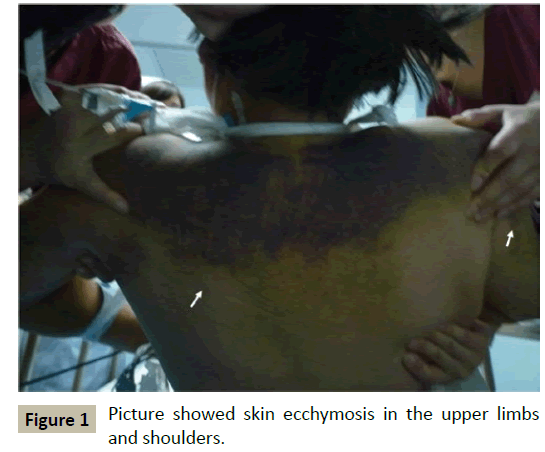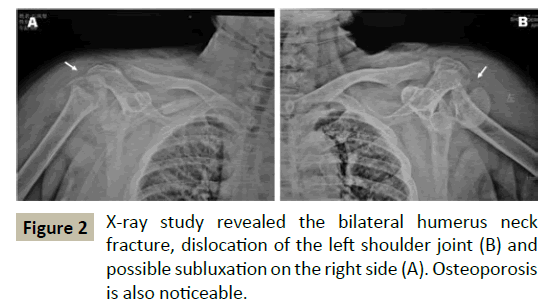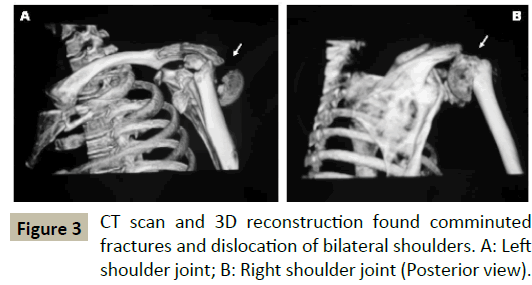Zhao Xiaojing*, Niu Zequn and Wang Gang
Department of Emergency medicine, the
Second Affiliated Hospital of Xian Jiaotong
University, Xi Wu Road, Xian, 710004, China
- *Corresponding Author:
- Xiaojing Zhao
PhD, MD, Department of Emergency
medicine
the Second Affiliated Hospital of
Xian Jiaotong University, Xi Wu Road, Xian,
710004, China
Tel: +8602987679403
Fax: +8602987678634
E-mail: zxj47@aliyun.com
Received: May 11, 2016; Accepted: May 23, 2016; Published: May 30, 2016
Citation: Xiaojing Z, Zequn N, Gang W. Skin
Ecchymosis with Schizophrenia Revealed
Hidden Bone Fractures. J Intensive & Crit
Care 2016, 2:2.
Keywords
Skin ecchymosis; Bone fractures; Schizophrenia; Physical examination
Introduction
Patients with schizophrenia are difficult to be communicated
with and clear signs cannot be obtained easily through physical
examinations for doctors. Accordingly, it is hard to make an
accurate diagnosis with limited information provided by the
patients and their family members. People with schizophrenia
have elevated pain threshold, pain tolerance and sensory
threshold compared to the controls, as well as reduced
physiological response to noxious stimuli [1]. They are more
prone to the osteoporosis and bone fractures due to their reduced
social activity, malnutrition, smoking, alcohol abusing and low
vitamin D levels [2-5]. Detailed medical history and thorough
physical examinations are necessary for doctors to avoid possibly
wrong diagnosis and misguided treatments. We present a case
report identifying the process of diagnosis and treatment for a
patient with fever and skin ecchymosis. The case report clearly
shows that the patient’s past history of schizophrenia should be
taken into account.
Case Report
A 66 year old woman was admitted to the department of
emergency with convulsion and confusions for five days. The
generalized convulsion began acutely after lunch, with clinical
manifestations of frothing at the mouth, muscle rhythmic jerking
and urinary incontinence, and it was self-limited but followed by
drowsiness and confusion. She was immediately sent to a local hospital with 37.8°C, 112 beats/min, 22 beats/min and 70/40
mmHg for her body temperature, pulse, respiratory rate and
blood pressure, respectively, on admission. The patient was then
initially diagnosed as “septic shock” and received treatments
of antibiotics and fluid resuscitation in the local hospital. She
underwent lumbar puncture twice without any abnormal result
of cerebrospinal fluid (CSF) test. After the treatment for five days,
no convulsion was observed even without any anti-convulsive
treatment, and meanwhile the blood pressure returned to normal.
With confusion and low-grade fever remaining with the patient,
she was transferred to our hospital after five days treatment
in the local hospital. The patient had a history of schizophrenia
and had been taking Risperidone for 20 years. She lost social
communication capacity due to carbon monoxide poisoning one
year ago. The family members of the patient denied illicit drugs
abusing (intravenous or otherwise). There was no past history of
trauma and operation. Her vital signs were normal except with a
body temperature of 37.5°C, pallor in face and conjunctiva, and
skin ecchymosis in upper limbs and more seriously in elbows on
admission. It was clearly noted that the patient had cervical and
thoracic hyperhidrosis, and her upper limbs crossed on her chest
without any active movement. Her cranial CT and chest CT showed
none of special abnormalities. Blood examination found reduced
erythrocyte count (2.07 × 1012/L) and hemoglobin concentration
(65 g/L). She was taken physical examination thoroughly and found a large area of skin ecchymosis in the shoulders and napex
(Figure 1). The edge of the lesion had partially faded away and
the skin ecchymosis turned yellowish in some areas (Figure 1).
The upper limbs were restricted in flexion position, and the left
upper limb had higher muscle tension compared with the right
side. She was found nervous, painful and much more cervical
and thoracic hyperhidrosis when her upper limbs were moved
passively. The family members were interviewed for the medical
history of the patient, which revealed that she had fall 20 days
ago and consequently she displayed limited movement of the
upper limbs. However, no medical examination and treatment
had ever been administrated before admission to the local
hospital. X-ray measurement confirmed osteoporosis, bilateral
humerus neck fractures, dislocation of the left shoulder joint
and subluxation of the right shoulder joint (Figure 2). Three
dimensional (3D) reconstructions after CT scan of the shoulder
showed comminuted fractures and dislocation of bilateral
shoulders (Figure 3). The patient was then transferred to the
department of orthopedics for further treatment.
Figure 1: Picture showed skin ecchymosis in the upper limbs and shoulders.
Figure 2: X-ray study revealed the bilateral humerus neck fracture, dislocation of the left shoulder joint (B) and possible subluxation on the right side (A).Osteoporosis is also noticeable.
Figure 3: CT scan and 3D reconstruction found comminuted fractures and dislocation of bilateral shoulders. A: Left shoulder joint; B: Right shoulder joint (Posterior view).
Discussion
Doctors have to make accurate diagnosis from any medical
conditions, which is essential to explain all the clinical
manifestations and laboratory tests. Otherwise the following
management may be inappropriate. In this case, the initial
diagnosis of “septic shock” was not fully supported by
manifestations and examinations and resulted in failure in
antibacterial treatment. The convulsion was probably due to the
low blood pressure resulting from the hemorrhage shock, and
never attacked the patient again after admission. For patients
with schizophrenia have decreased pain sensitivity and reduced
physiological response to noxious stimuli [1], doctors’ attention
could be easily attracted by the medical history of long-term
Risperidone administration, whose side effects often include
epilepsy, rigidity and hypotension and thereby high likelihood of
fall. The shoulder fracture initially due to the fall without prompt
treatment 20 days ago may also be ignored. The probable recurrence of epileptic seizures could worsen the bone fracture
and cause injury of the soft tissue and ecchymosis of the skin,
which could aggravate the hypotension. Moreover, the continuing
subcutaneous bleeding would keep resulting in ecchymosis of
the skin, anemia, absorbing fever, and leukocytosis, which was
inflammatory response from trauma. Therefore, we suggest
thorough history collection from the family members of the
patient, which might provide us new clues. In this case, when the
large area of skin ecchymosis was found on the shoulders and
napex without significant abnormality such as coagulopathy and
obvious injury, bone fractures should be excluded, especially,
under such condition that patients failed to cooperate with the
physical examination properly. Skin ecchymosis is recognized as
an indirect signs of the closed fractures [6]. However, it is rare
to present on such a large area of the skin, which even lead
to the hemorrhagic anemia and hypotension mainly due to
the repeated injury from the bone fracture. In addition, more
attention should be paid to the side effects of Risperidone,
which also causes osteoporosis and fractures [6-9]. Above all,
decreased pain sensitivity among people with schizophrenia indicates that difficult recognizing pain was an issue for doctors,
and also healthcare staff. Thorough physical examination,
detailed medical history taking and necessary lab tests should be
combined together for patients with mental illnesses.
Conclusion
When the initial diagnosis could not explain all the manifestations
of a patient and responding treatment could not relieve signs and
symptoms thoroughly, detailed examination and history inquiry should be conducted. Additionally, patients with schizophrenia
should be examined carefully for hidden bone fractures,
especially when they are either complicated with skin ecchymosis
or administered with oral Risperidone for a long period.
Acknowledgement
The authors would like to extend their gratitude to the patient
and her family members for help in completion of this article.
References
- Stubbs B, Thompson T, Acaster S, Vancampfort D, Gaughran F, et al. (2015) Decreased pain sensitivity among people with schizophrenia: a meta-analysis of experimental pain induction studies. Pain 156: 2121-2131.
- Stubbs B, De Hert M, Sepehry AA, Correll CU, Mitchell AJ, et al. (2014) A meta-analysis of prevalence estimates and moderators of low bone mass in people with schizophrenia. Acta Psychiatr Scand 130: 470-486.
- Stubbs B, Gaughran F, Mitchell AJ, De Hert M, Farmer R, et al. (2015) Schizophrenia and the risk of fractures: a systematic review and comparative meta-analysis. Gen Hosp Psychiatry 37: 126-133.
- Kishimoto T, De Hert M, Carlson HE, Manu P, Correll CU (2012) Osteoporosis and fracture risk in people with schizophrenia. Current Opinion in Psychiatry 25: 415-429.
- Agorastos A, Weinas A, Agorastos AD, Wiedemann K (2011) Psychosis-induced vitamin D deficiency with secondary hyperparathyroidism and osteoporotic fractures. General Hospital Psychiatry 33: e3-e5.
- Tubbs RS, Shoja MM, Loukas M, Oakes WJ, Cohen-Gadol A (1974) Mastoid ecchymosis. Battle's sign of basal skull fracture. Minnesota Medicine 57: 263-265.
- Graham SM, Howgate D, Anderson W, Howes C, Heliotis M, et al. (2011) Risk of osteoporosis and fracture incidence in patients on antipsychotic medication. Expert Opinion on Drug Safety 10: 575-602.
- Laekeman G, Zwaenepoel L, Reyntens J, de Vos M, Casteels M (2008) Osteoporosis after combined use of a neuroleptic and antidepressants. Pharmacy World & Science 30: 613-616.
- Meaney AM, O'Keane V (2007) Bone mineral density changes over a year in young females with schizophrenia: relationship to medication and endocrine variables. Schizophrenia Research 93: 136-143.




